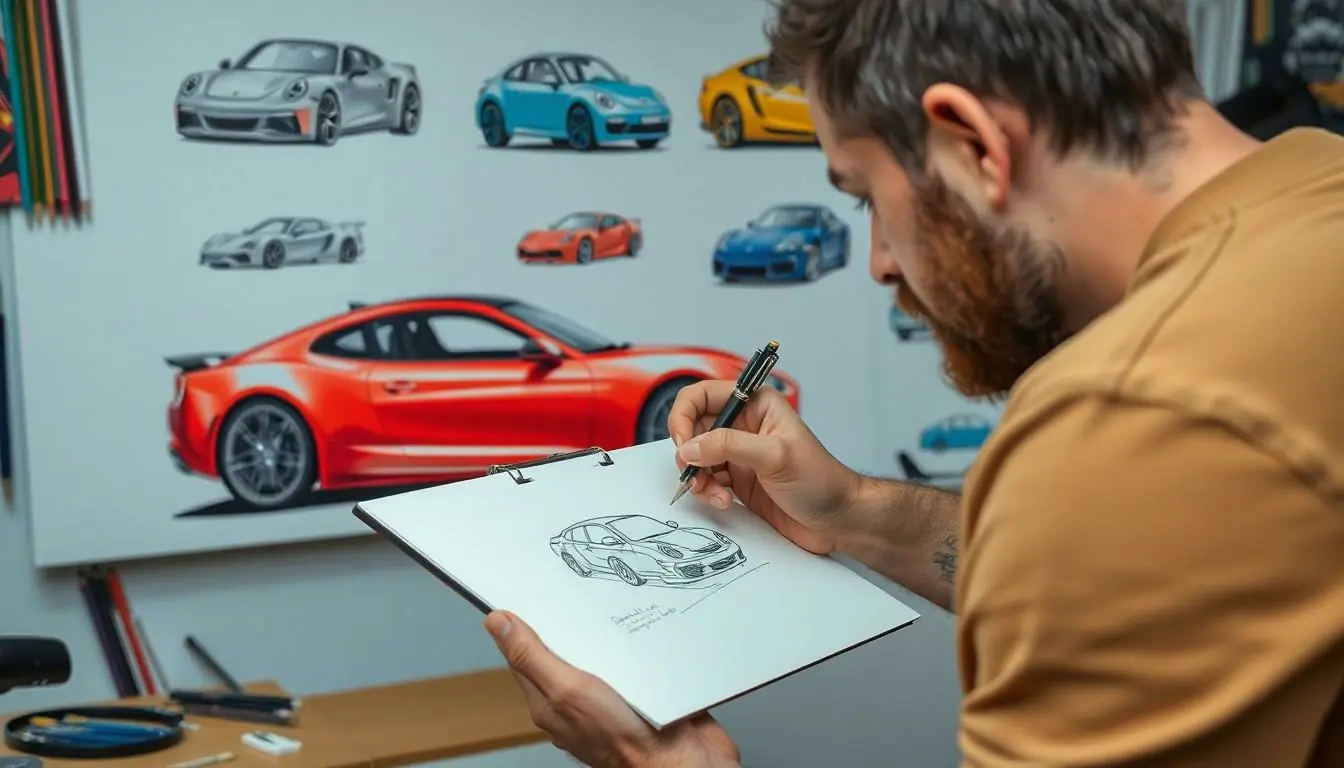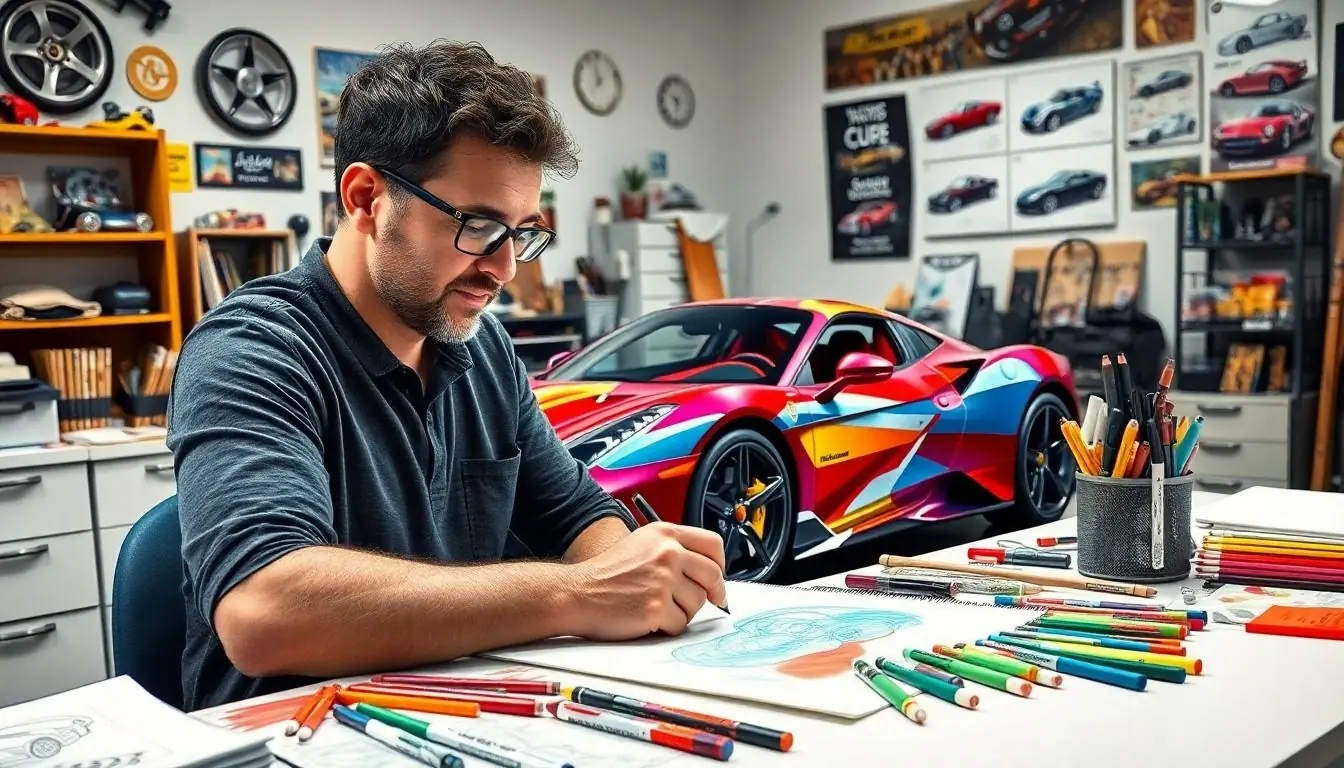Table of Contents
ToggleCar pictures drawing isn’t just for aspiring artists; it’s a gateway to unleashing creativity and showcasing automotive passion. Whether it’s a sleek sports car or a classic vintage ride, capturing these machines on paper can be a thrilling adventure. Imagine the joy of transforming a simple sketch into a masterpiece that revs up conversations and admiration from friends and family.
Overview of Car Pictures Drawing
Car pictures drawing serves as both an artistic pursuit and a celebration of automotive culture. Artists engage deeply with their subjects, finding joy in the intricacies of car design.
Importance in Art
Car pictures drawing holds significant value in the art world. It showcases technical skills through precise lines and accurate proportions. Emotion often shines through in each piece, evoking feelings tied to nostalgia or excitement. Many artists use car drawings to convey personal stories or societal themes. Each artwork reflects the artist’s passion, attracting audiences who appreciate automotive history or appreciate fine detail. By doing this, car drawings foster a unique connection between automobiles and artistic expression.
Techniques Used
Various techniques contribute to the creation of compelling car pictures. Pencil sketches often serve as a foundation, allowing artists to experiment freely. Color markers can enhance the vibrancy and impact of the images. Watercolors add depth and creativity, blending tones for a dynamic effect. Digital tools, including software applications and tablets, allow for precise modifications and effects. Artists frequently explore different perspectives, focusing on angles that highlight features. Each method brings a distinct style, showcasing the versatility of car drawing techniques.
Types of Car Pictures Drawing

Car pictures drawing encompasses various styles that artists utilize to showcase automobiles. Two prominent types include realistic and stylized drawings, each offering distinct interpretations of vehicles.
Realistic Drawings
Realistic drawings aim for precision and detail, capturing every nuance of a vehicle’s design. Artists focus on elements like lighting, shadow, and texture to mimic real-life appearances. Techniques such as shading and perspective enhance the authenticity of realistic car pictures. Many artists study photographs closely to achieve lifelike representations. Such drawings often evoke strong emotions, engaging viewers with their impeccable craftsmanship. Examples include highly detailed renderings of luxury cars or vintage models, showcasing their unique features and aesthetics.
Stylized Drawings
Stylized drawings take creative liberties, allowing artists to express personal interpretations of vehicles. This type emphasizes artistic flair over strict realism, often incorporating vibrant colors and dynamic lines. Styles can range from minimalist designs to exaggerated forms, providing a sense of movement or personality. Artists frequently employ techniques like pop art influences or abstract shapes in these creations. Stylized car pictures invite viewers to appreciate automobiles through an imaginative lens. Examples include cartoonish representations of classic cars or innovative concept vehicle designs, demonstrating the flexibility of artistic expression.
Tools and Materials for Car Pictures Drawing
Drawing car pictures requires specific tools and materials to enhance creativity and precision. Selection greatly influences the final outcome, so consider quality over quantity.
Pencils and Charcoal
Pencils serve as fundamental tools for sketching car designs. Varied grades, from H for light lines to B for darker tones, provide flexibility in detailing. Additionally, charcoal adds depth and richness, allowing for dramatic shading that enhances realism. Artists often prefer blending stumps to achieve smooth transitions. Techniques like cross-hatching and stippling can create intricate textures and lifelike effects. Many artists achieve striking contrasts by using both mediums, generating stunning visuals with depth and character.
Digital Drawing Software
Digital drawing software transforms how artists create car images. Programs like Adobe Illustrator and Procreate offer robust tools for precision and customization, supporting various styles. Layers allow for an organized approach, making adjustments simple and efficient. Brushes can mimic traditional textures, providing versatility in techniques. Many artists utilize vector graphics to maintain quality when resizing. Regular updates enhance features, keeping artists engaged with new possibilities. Digital platforms also facilitate sharing, connecting artists with a broader community.
Steps to Create Car Pictures Drawing
Creating captivating car pictures involves various techniques and steps that enhance the final artwork. Each phase contributes to a richer representation of the automobile.
Sketching the Outline
Begin by capturing the basic shape of the car. Using light strokes allows for easy adjustments as the drawing evolves. Focus on accurately depicting the proportions and perspective to establish a strong foundation. Include key elements such as the wheels, windows, and body contours. Emphasize identifying the car’s model for an authentic touch. Artists often employ reference images to ensure precision. Ultimately, this stage sets the tone for the entire drawing.
Adding Details and Shading
Incorporate intricate details that define the vehicle’s character. Characters like headlights, grills, and reflections add realism to the drawing. Shading techniques come into play to create depth and dimension. Utilize different pencil grades to achieve a range of contrasts. Layering can enhance the texture, allowing metallic surfaces to shine. Artists may also experiment with cross-hatching or stippling for expressive detailing. This approach transforms the initial outline into a vibrant representation of the car.
Car pictures drawing serves as a vibrant intersection of art and automotive passion. Artists find joy in expressing their creativity through various styles and techniques, whether capturing the intricate details of a classic car or the dynamic lines of a modern sports model. Each drawing tells a unique story, fostering a connection between the viewer and the subject.
The versatility of materials and tools available today empowers artists to explore their craft in innovative ways. From traditional pencil sketches to digital masterpieces, the possibilities are endless. Ultimately, car drawings not only celebrate automotive culture but also highlight the emotional ties individuals have with these machines, making it a rewarding artistic pursuit.




